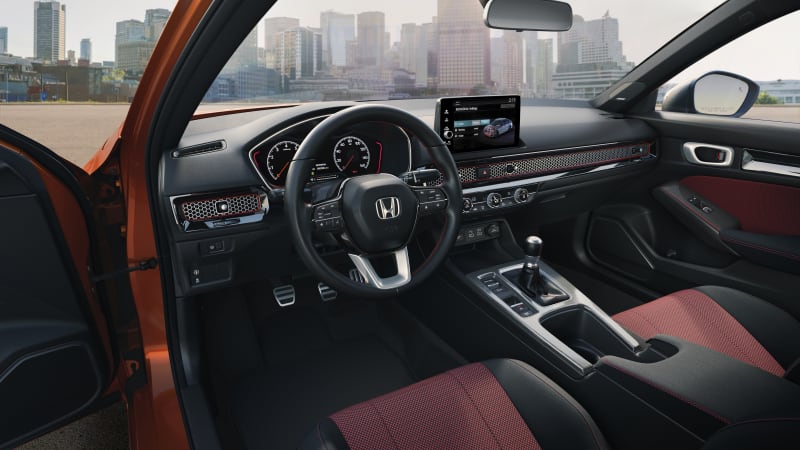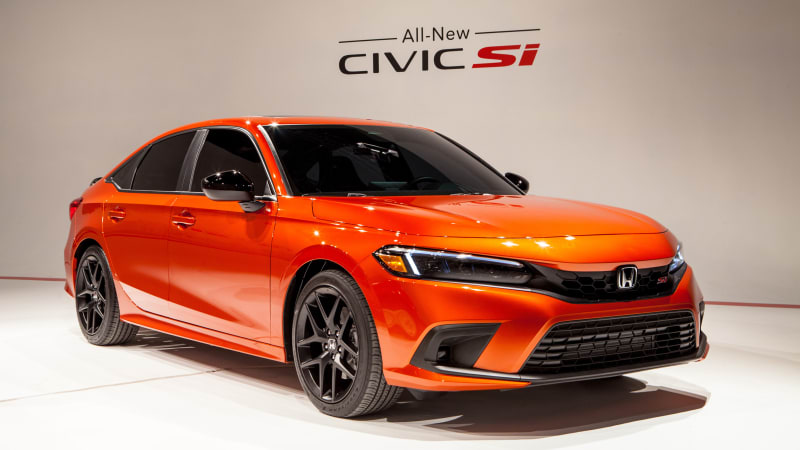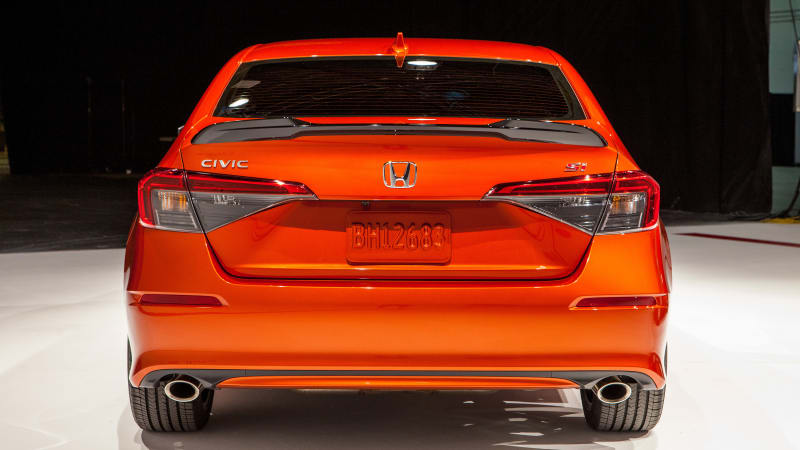SIGNAL HILL, Calif. — The majority of Americans may see the 2022 Honda Civic as a trusty but mundane economy offering, but that’s a bad rap. Sport variants of the Honda Civic have been part of the company’s North American offerings for nearly 40 years, dating way back to the nameplate’s second generation.
It all began in 1983 with the Honda Civic S hatchback. The “i” wasn’t part of the name yet, as it didn’t yet use electronic fuel injection, though it did come with a larger 1.5-liter engine than the standard 1.3, and it was visually denoted with red pinstriping and a red “S” badge.
The 2022 Honda Civic Si continues that tradition, this time around based on the 11th-generation Civic. Honda told Autoblog that it chose to use the sedan as a basis (the coupe is sadly dead) because the Civic Sport Touring and upcoming Civic Type R already take on the hatchback form factor. The Si sedan splits the difference and gives buyers a sporty four-door option. Also, because the regular Civic sedan is CVT-only, the Civic Si gives sedan buyers the option of six-speed manual. In fact, as before, it’s the only gearbox offered.
Honda bills the 2022 Civic Si as the best-handling and most fun-to-drive Civic Si yet, and given the stellar performance of past examples those are big claims. Some of the improvements come from the generational redesign across the Civic lineup, like a wheelbase that grows by 1.4 inches to 107.7, an 0.5-inch wider track, torsional rigidity upped by 8%, and bending rigidity improved by 13%. These should result in a smoother ride and a more stable feel at speed.
From that foundation, Honda adds more advances that are Si-specific. There’s unique tuning for the dampers, spring rates are 8% stiffer, and a hollow 27-mm stabilizer bar should provide better cornering abilities. Steering feel, too, should see an improvement thanks to a 60% stiffer steering torsion bar. The current Civic Type R contributes some bushings as well. They’re 79% stiffer than the EX sedan’s.
At the rear, it’s a similar story. Upper and lower B arms are also plucked from the Type R, matched with an 18-mm solid sway bar and springs that are 54% stiffer. This should make the Civic Si an even more potent corner-carving weapon than before.
The engine remains a 1.5-liter turbocharged inline-four, but it’s retuned for broader power curves. Though horsepower drops from 205 at 5,700 rpm to an even 200 at 6,000 rpm, Honda says the curve at the top end keeps peak output going longer to the 6,500 rpm redline. Peak torque stays the same at 192 pound-feet but kicks in 300 rpm sooner and keeps at it from 1,800-5,000 rpm. Thanks to turbo technology, the 2022 Civic Si more than doubles the 91 horses and 93 lb-ft of torque from the 1986 Si that Honda also displayed here in Signal Hill for some historical perspective, while maintaining a more usable power band.
Throttle response should see a marked uptick as well, now that the Si comes with a single-mass flywheel that’s 26% lighter than the 10th generation’s dual-mass unit, resulting in 30% less inertia. Any worry of a fast-dropping tach needle is mitigated by the fact that the six-speed now comes standard with the rev-matching throttle blip from the Civic Type R. The gearbox is now topped by a short-throw shifter reducing required movement by 10%. It also has a nice, solid-y feel (at least while parked).
Separating all that from the front wheels is a standard helical limited-slip differential that should make it a real hoot to sling hard. The Si also benefits from a throatier growl than run-of-the-mill Civics, as there’s a new dual-coil silencer exhaust system that opens flow by 27% compared to the 2022 Civic Touring. When you give it gas, the numbers on the 7-inch digital instrument cluster tach light up as the needle sweeps its digital face. An active sound control system helps enhance the sound, if you’re into that kind of thing.
The 2022 Civic Si’s driving modes have been upgraded as well. Sport mode now reduces the boost on the power steering in addition to making the throttle more responsive. It also turns off the automatic stop-start so you can be ready for launch. Perhaps more importantly, the car now adds an Individual mode that allows you to personalize your steering and throttle settings to your own preferences.
Visually, the changes are minimal. Honda told us it wanted to go back to a more subtle approach, where the Si wasn’t “shouty” but dropped just enough clues so those in the know would notice something special. It comes with a unique grille accented by a red “Si’ badge in the corner. The nose is actually shared with the Civic Hatch, not the standard sedan, which Honda believes is a sportier look. It’s a mostly clean design even if a bit bulbous at the front and with the little wrinkle by the C-pillar glass that is very distracting. Still, we’re thankful they’ve eschewed the fake vents of its predecessor.
Honda says it went through great lengths to make the A-pillars thin, and they do look that way from the outside. Once you’re in, however, the mandated safety equipment still encroaches quite a bit into your field of vision. No one can ever go back to the 1986’s incredible visibility, but at least they’re not as chunky as on many of its competitors’.
A front spoiler lurks beneath the nose, while a visible black rear spoiler sits on the decklid. Minor differences like gloss black side mirrors and window trim help distinguish the Si. If that’s not enough to set you apart, the Si comes in an exclusive Blazing Orange Pearl paint not available on lesser Civics. All Civic Si models have 18-inch 10-spoke wheels finished in matte black rather than the standard gloss black, but the effect actually looks rather cheap.

Cabin-wise, the Si has a few exclusive interior touches, the most important of which is the more prominent bolstering of the front buckets in both upper and lower sections. They felt very nice while stationary at least, supportive but not enveloping, striking a good balance between sport and comfort. Honda embroidered Si logos in them as well, and red contrast stitching can be found throughout the cabin.
The dash has a red line encircling the hexagon vents, mimicking the red pinstripes from the original Civic S. These are nice touches, but we would pass on the plasticky plates surrounding the window switches if they weren’t standard on the Si. Some of the harder materials seemed like they would wear out quickly but we hope to be proven wrong. Aluminum pedals (and the fact that they’re three) also set it apart from normal Civic sedans.
All Civic Si models get Honda’s much improved 9-inch touchscreen standard, along with wireless Apple CarPlay and Android Auto. A 12-speaker Bose Centerpoint 2 sound system feeds the cabin with SurroundStage digital signal processing, and it’s all standard equipment for the Si. The climate control continues to use physical knobs.
On paper the Civic Si seems like it will continue to do a fine job of offering an affordable sporty car for the masses. It has grown, weighing 46 pounds more than its forebearer for a total of 2,952 pounds, and if we had the choice, we’d probably do without some bells and whistles like the fancy sound system or active sound enhancements for a purer driving experience. Still, in this market beggars can’t be choosers, and Honda should be commended for offering something for as many Civic buyers as they can between the base and Type R.
Source: www.autoblog.com








